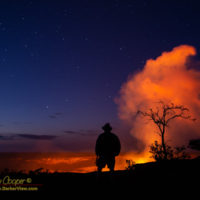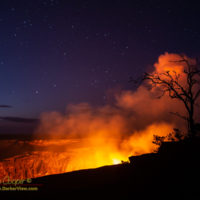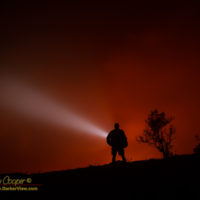The lava burst forth from the crater wall just before Christmas. After two years of quiet the volcano has again erupted. Within hours the lake of water that had been slowly growing had been boiled away in a huge plume of steam.
I knew within minutes that an eruption had begun, tapped into the island grapevine. While I considered making a midnight run across island I had to bow to the needs of life and regretfully went to bed.
Now well into the new year I finally had a chance to photograph the new lava lake.
The lake has not yet risen far enough to be visible from the park service viewpoints, that might take a few months assuming the level continues to rise. What you do see is the glowing plume rising above the lake and the radiance on the crater walls.
I knew There would be no lava to be seen directly this time. I planned to shoot the glowing pit and plume in the night. The equipment I packed chosen for this… The Canon 6D, a heavy tripod, and the fast lenses. I also packed the Syrp Genie Mini for some video work.
It was playing tour guide for my parents that allowed me a chance to photograph the volcano. A night booked at Kilauea Military Camp allowed an easy run across island without having to drive back home the same day. Staying right on the caldera rim makes it very easy to shoot multiple sessions of the crater in the night, the viewpoints mere moments away from the room.
We watched the volcano at sunset from Kilauea overlook, joining the evening crowds. The park service shuts off traffic to this overlook once the small parking lot is full, sending the overflow to one of the playing fields at KMC. You will have to walk to the overlooks, about a mile, with nice views of the crater along the way as the trail runs along the caldera rim.
Setting the alarm for 5am allowed another shoot in under the clear starry sky before dawn. The evening crowds are gone and there is plenty of parking at Kilauea Overlook. In mid-January Crux, the Southern Cross, sits well placed above the southern horizon just beside the glowing plume of volcanic gas.
The pre-dawn shoot produced the best photos of the night. If you want to shoot the volcano I highly recommend a dawn shoot. No crowds, clear skies, reliably better conditions and photos.
Yet one more walk out to the rim right in front of KMC at sunrise showed the caldera with the low light of dawn streaming across the floor. The heavy plume of the night before is gone and a wispy cloud ascends into a blue sky.
This time I shoot more video and enjoy other features of the caldera. The cool morning air allows the various fumaroles and steam vents to be more easily seen, large plumes of vapor streaming into the still air. The view of steaming bluff clearly shows how it received the name.
The result? A nice easy volcano run and some nice photos to show for it. The room at KMC made logistics really easy, a place to crash and recharge camera batteries within a short walk if the caldera. Just waiting for the lake to rise or the next phase of this eruption to make another run to the volcano.





